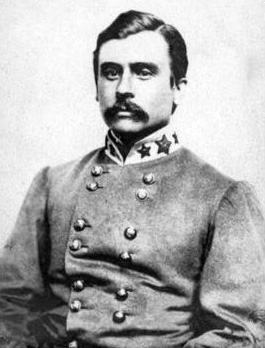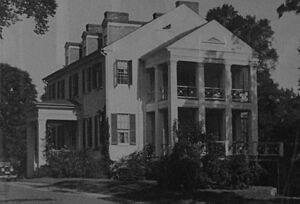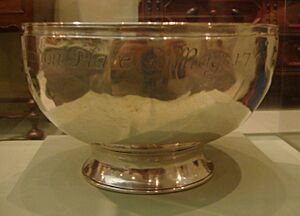Steuart family facts for kids
Quick facts for kids Steuart |
|
|---|---|
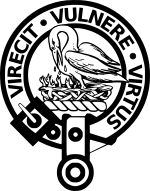
Steuart family crest
|
|
| Current region | Anne Arundel County, Maryland. |
| Earlier spellings | Stewart, Stuart. |
| Etymology | Stewards of Scotland |
| Place of origin | Perthshire, Scotland |
| Members | George H. Steuart (planter) (1700-1784) George H. Steuart (militia general) (1790-1867) George H. Steuart (brigadier general) (1828-1903) Richard Sprigg Steuart (1797-1876) |
| Connected families | Calvert family |
| Estate(s) | Dodon, Old Steuart Hall |
The Steuart family of Maryland was a very important political family in the early history of Maryland. They came from Scotland, specifically from a place called Perthshire.
The Steuarts became quite rich in the early 1700s. This was thanks to the Calvert family, who owned the Maryland colony. However, the Steuarts lost a lot of their money and power during the American Revolution and the American Civil War.
| Top - 0-9 A B C D E F G H I J K L M N O P Q R S T U V W X Y Z |
A Look at Steuart Family History
The Steuart family has a long and interesting history in Maryland. They played a big part in the colony's early days. Their story shows how major events like wars can change a family's future.
George Hume Steuart: A New Beginning in Maryland
George Hume Steuart (1700–1784) was a doctor who studied in Edinburgh, Scotland. Around 1721, he moved to Annapolis in the Maryland colony. There, he started his medical practice.
He got married and became a successful tobacco farmer and politician. George Steuart worked closely with the Calvert family. They were the owners of the Maryland colony.
In 1742, Charles Calvert, 5th Baron Baltimore sent his young son, Benedict Swingate Calvert, to Annapolis. He placed the boy in Steuart's care. This connection helped Steuart get many important jobs in the colony.
Choosing Sides in the American Revolution
George Steuart owned land in both Maryland and Scotland. When the American Revolution began, he had a tough choice. He had to decide whether to stay loyal to the British King or join the American rebels.
He couldn't stay neutral. So, in 1775, he sailed back to Scotland. He lived there until he passed away in 1784. However, his sons stayed in Maryland and supported the new United States of America.
Major General George H. Steuart: A Military Leader
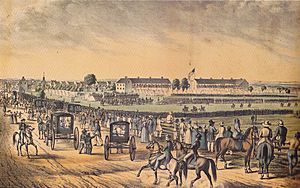
George Steuart's grandson, Major General George H. Steuart (1790–1867), was a United States general. He fought in the War of 1812. His military career started in 1814.
As a young captain, he gathered a group of Maryland volunteers called the Washington Blues. He led them in the Battle of Bladensberg and the Battle of North Point, where he was hurt. After the war, he became a major general in the Maryland Militia.
The Civil War and Family Choices
In 1861, when the American Civil War started, Steuart was 71. He was too old for active fighting. Even though Maryland stayed with the Union, he left his home state. He joined the Confederacy.
Many Steuart family members owned enslaved people. They supported the Confederacy. On April 16, 1861, George H. "Maryland" Steuart was an officer in the United States Army. He quit his job to join the Confederacy.
Because they fought for the Confederacy, the U.S. government took away much of the family's property. For example, Old Steuart Hall was taken by the Union Army. Jarvis Hospital was built there to care for wounded Union soldiers. The family's wealth and standing never fully recovered after the war.
Another Steuart, the surgeon William Frederick Steuart, also joined the Confederate side.
Important Steuart Family Members
The Steuart family tree includes many notable individuals. Here are some of the most well-known members and their connections:
- George H. Steuart (planter) (1700–1784)
- George Steuart Hume (1747–1787), a doctor. He went back to Scotland to take over the family's land in Perthshire.
- Dr Charles Mark Steuart, a doctor (1750–1798)
- Dr Charles Calvert Steuart, a doctor (1784–1836)
- William Frederick Steuart (1816–1889), a surgeon who served in the Confederate Army during the Civil War.
- Captain George Biscoe Steuart (1817-1881)
- Dr Charles Calvert Steuart, a doctor (1784–1836)
* George H. Steuart (physician) (1865-1945) ** George H. Steuart (diplomat) (1907–1998)
-
- William Steuart, a wealthy farmer (1754–1838)
- Dr James Steuart of Annapolis (a doctor) (1755–1846). He was the Baltimore Commissioner of Health in 1805.
- George H. Steuart (militia general) (1790–1867), who gathered volunteers and was wounded in the War of 1812.
- George H. Steuart (brigadier general) (1828–1903), who fought for the Confederate States of America in the Civil War.
- Lieutenant William James Steuart (1832–1864), C.S.A. He was killed at the Battle of the Wilderness in 1864.
- Richard Sprigg Steuart (1797–1876), who started the Maryland Hospital for the Insane in Catonsville, Maryland.
- Dr James Aloysius Steuart (1828–1903). He was the Baltimore Commissioner of Health from 1873-1882.
- George H. Steuart (militia general) (1790–1867), who gathered volunteers and was wounded in the War of 1812.
Steuart Family Homes
The Steuarts built several homes in Maryland. Sadly, none of them are still completely standing today. Here are two important ones:
- Maryland Square, a large house on the edge of Baltimore, Maryland. The Steuart family owned it until 1861. At the start of the American Civil War, the United States Federal Government took it. In 1862, Jarvis Hospital was built on the land to care for wounded Union soldiers. The house itself was used as the hospital's main office.
After the war, the house was given back to Brigadier General George H. Steuart in 1866. But he never lived there again. He chose to live at Mount Steuart, his family's property in Anne Arundel County. The building was sold and became a school for boys called Steuart Hall. In 1884, the house was torn down. The Grace Medical Center stands there now.
- Dodon, a farm and former tobacco plantation. It was about 550-acre (2.2 km2) and located near the South River. This is about 10 miles (16 km) southwest of Annapolis. Today, the eighth generation of Steuarts still lives there. They continue to farm and raise horses for racing. Parts of the original house are still there, but most of it was destroyed in a fire around 1950.
Horse Racing and the Steuart Legacy
George H. Steuart (1700–1785), who founded the Steuart family in Maryland, loved breeding horses. He started the Annapolis Subscription Plate. This was the name for both the first official horse race in colonial Maryland and the silver trophy given to the winner. It is the second oldest known horse racing trophy in America. The race happened in 1743, and Steuart's horse, Dungannon, won it.
The Steuart Name Today
The unique spelling of "Steuart" was common in the 1700s. Back then, "Steuart," "Stewart," and "Stuart" were often used interchangeably. However, this spelling is not very common anymore. But, Steuart's many descendants in North America have kept the old spelling.
In 1955, the Maryland Jockey Club ordered a silver copy of the original Annapolis Subscription Plate. This "Dungannon Bowl" is a special trophy given to the winner of the annual Dixie Stakes. This is the oldest stakes race held in Maryland and the Mid-Atlantic states.
A stone monument at Dodon marks where Richard Sprigg Steuart and other family members are buried. Brigadier General George H. Steuart and his father, Major General George H. Steuart, are both buried under a family monument at Green Mount Cemetery in Baltimore. The Steuart Hill area of Baltimore is named after the family, showing their long connection to the city.
See also
- Colonial families of Maryland
- Clan Stuart
Images for kids
-
William Steuart, planter
-
Richard Sprigg Steuart, founded the Maryland Hospital for the Insane
-
William Frederick Steuart CSA, Surgeon to the 1st North Carolina Infantry


